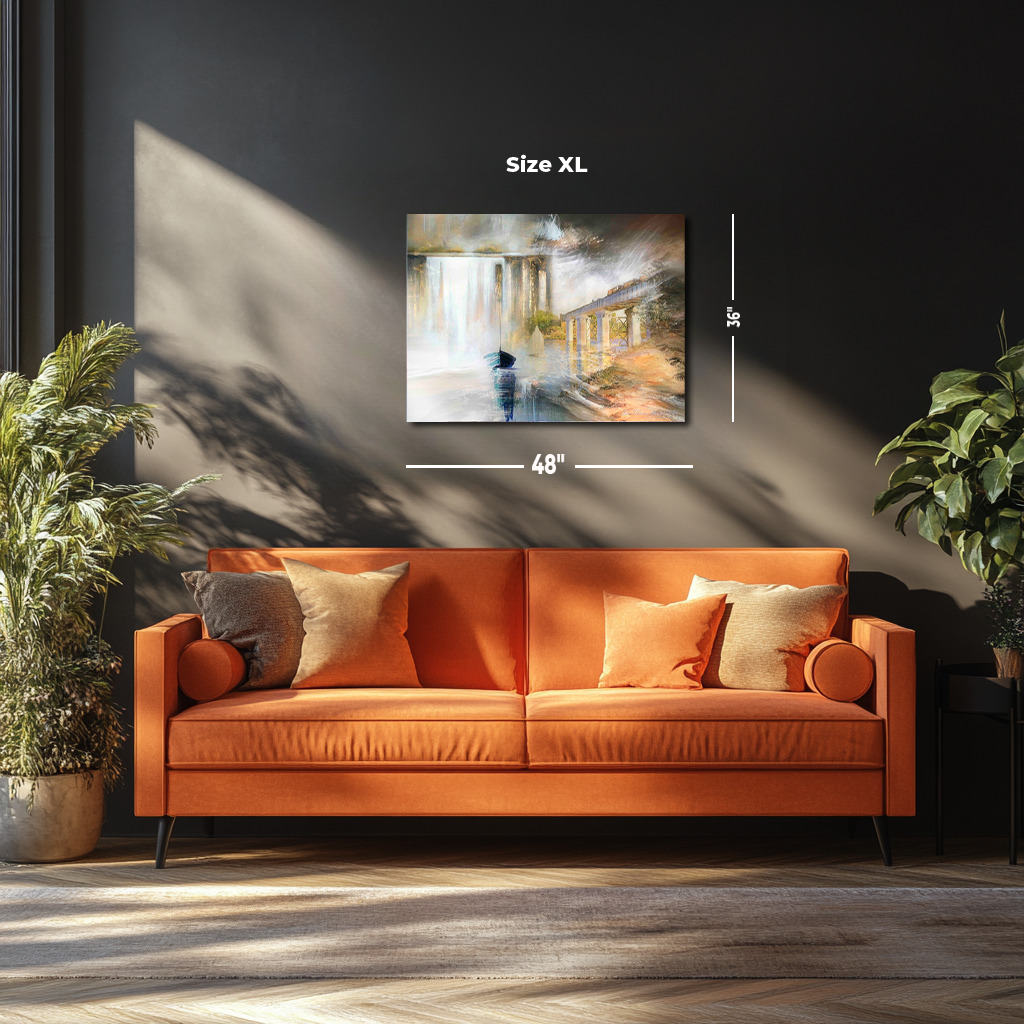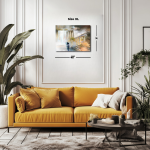The Convergence of Motion and Stillness
This abstract reimagining of Monet’s The Railroad Bridge at Argenteuil (1873) transforms a scene of industrial serenity into a landscape caught between stability and motion. The original bridge, a symbol of human ingenuity, dissolves into cascading waterfalls, blurring the line between man-made structure and natural force. A lone boat drifts between these two realities, suspended in a moment where past and future merge. The golden tones of the riverbank contrast with the ethereal whites and deep blues of the waterfall, emphasizing the clash between stillness and relentless change. This piece challenges the idea of permanence, questioning whether progress endures or eventually succumbs to forces beyond control.
Please see Below for Details…
Hotline Order:
Mon - Fri: 07AM - 06PM
404-872-4663
Claude Monet painted The Railroad Bridge at Argenteuil in 1873, capturing a serene yet industrialized landscape where modernity and nature intersect. The sturdy bridge, with a train passing over it, reflected Monet’s fascination with movement and how light played upon water and metal. Below, the river remains calm, reflecting the structures above it, while small sailboats glide peacefully, creating a contrast between human innovation and natural tranquility.
In this surreal transformation, the quiet river scene has been split into two realms, one of stillness and one of unstoppable force. The right side of the image remains true to Monet’s original vision—the bridge stands firm, connecting land across the water, with reflections shimmering softly below. The earthy tones of the riverbank and the soft, diffused light of the sky create a warm, nostalgic atmosphere, reminiscent of a world in harmony with itself.
The left side, however, introduces an alternate reality. The train bridge fades into towering waterfalls that cascade from an ethereal sky. The columns of the waterfall resemble the rigid supports of the bridge, as if the industrial structure has melted into an elemental force beyond human control. A single boat, anchored in the reflective waters, seems suspended between these two worlds, caught between past and future, between the tangible and the abstract. The motion of the water disrupts the tranquility, transforming Monet’s gentle ripples into a powerful cascade that challenges the very stability of the landscape.
The color choices reinforce this juxtaposition of realities. The golden hues of the right side reflect warmth and the security of a grounded world, while the left side is dominated by misty whites and deep blues, evoking mystery, uncertainty, and the relentless movement of time. The blurred edges of the cascading water create an illusion of transition, as if the scene is dissolving into something beyond comprehension.
As an artist, my intention was to explore the delicate balance between progress and the unstoppable forces of change. Monet’s original work depicted a world where industry and nature coexisted, where the modern age integrated itself seamlessly into the landscape. This reimagining disrupts that harmony, pushing the viewer to consider the fragility of constructed reality. The waterfall, while majestic, hints at destruction, as if the solidity of human engineering can be swept away in an instant.
The train bridge was originally a symbol of movement and connection, a feat of human ingenuity. Here, it is contrasted with a natural force that is even more powerful, reminding us that no matter how permanent something may seem, time and nature can alter everything. The lone sailboat serves as an observer, much like the viewer, caught between these opposing elements. It is a vessel without a clear path, floating in a moment where stability and transformation collide.
Monet’s mastery lay in capturing fleeting moments of light and atmosphere, giving permanence to something transient. This piece expands upon that idea by questioning what happens when those moments stretch beyond what the eye can see. Does the peaceful river give way to a deluge Does progress endure, or does it eventually dissolve into something unrecognizable
By blending Monet’s gentle impressionism with abstract surrealism, this piece challenges the viewer to question their perception of permanence. The bridge, once a stable structure, now fades into fluidity, while the water, once calm, becomes an overwhelming force of movement. The image stands at the edge of two possibilities—the continuation of Monet’s world or the surrender to something entirely new.
Add your review
Your email address will not be published. Required fields are marked *
Please login to write review!
Looks like there are no reviews yet.










